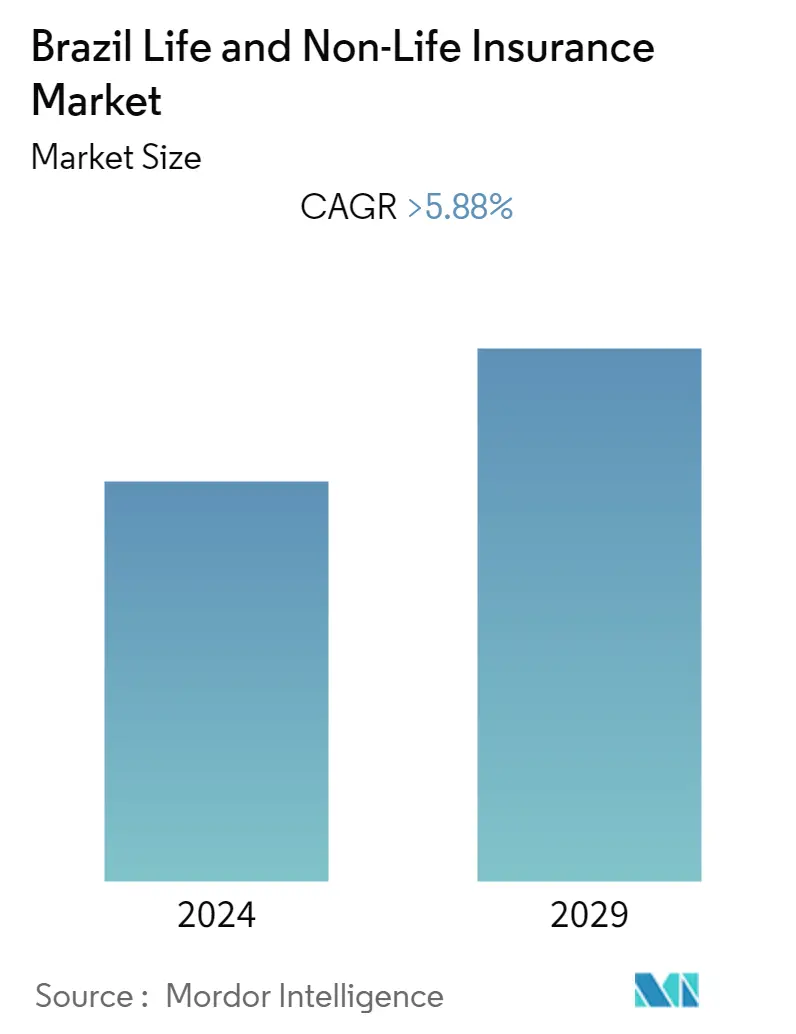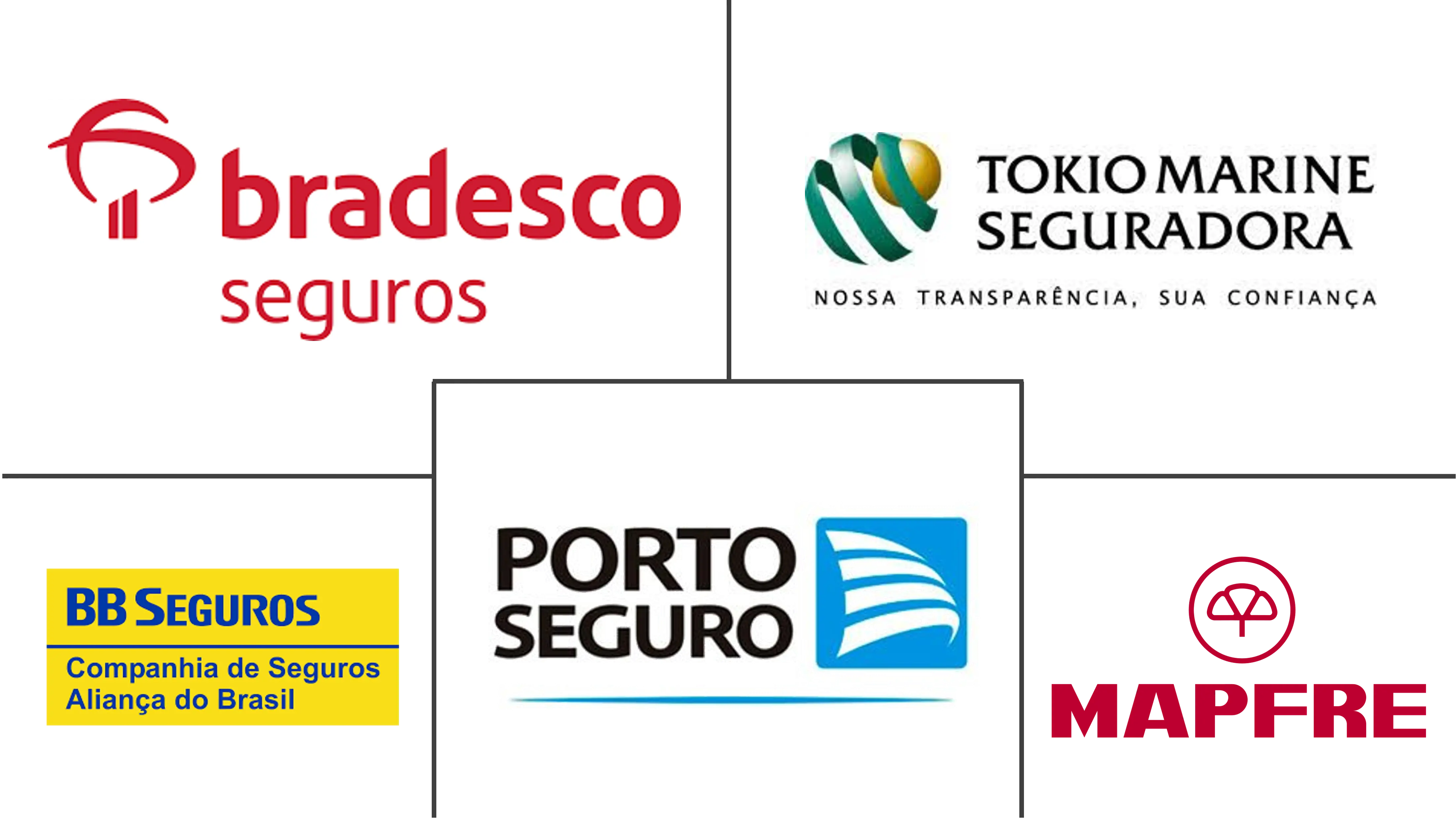Market Size of Brazil Life and Non-Life Insurance Industry

| Study Period | 2020 - 2029 |
| Base Year For Estimation | 2023 |
| Forecast Data Period | 2024 - 2029 |
| Historical Data Period | 2020 - 2022 |
| CAGR | 5.88 % |
| Market Concentration | Medium |
Major Players
*Disclaimer: Major Players sorted in no particular order |
Brazil Life Insurance and Non-life Insurance Market Analysis
The Life And Non-Life Insurance Market In Brazil by premium is valued at USD 27.96 billion in the current year and CAGR of 5.88% during the forecast period.
Brazil has a robust healthcare system that provides care to everyone who's abiding there fairly. The Sistema Unico de Saude (SUS) is the public health system in the nation that provides universal health coverage and multitudinous free services, including maternity care, dental care, precautionary care, primary care, inpatient care, and outpatient care. Although Brazil's public hospitals give high-quality care, they constantly have significant stay ages and are overcrowded. Also, public hospitals don't have the structure and amenities that private hospitals give, similar to air exertion or medical inventories. Indeed though nonnatives and deportees are eligible for free care at public hospitals, numerous of them choose to go to private hospitals rather than pay for the treatments out of their own pockets. The maturity of Brazilians with private health insurance admits it from their employers as part of their employment benefits package. An ex-pat over 50 times old will generally pay USD 124 a month for medical insurance, which includes a free comprehensive physical test, drug, hospitalisation in a private room, dental care, and vision care.
Industry premiums continued with a double-number growth line in 2022, with an increase of 16.2 versus 12 in 2021. All parts increased, with emphasis on the bus at 33 and property/ casualty (P/ C) at 21. Together, these two parts grew by 26.5 in 2022. The parts related to life and pension grew by 11.2, also above affectation in the same period. The uninterrupted growth in decorations incompletely reflects price adaptations due to affectation, life insurance consumer growth and signs of further profitable exertion in 2022. The Brazilian GDP rose for the fifth successive quarter, growing by 3.2 up to 3Q22 compared with 2021. Affectation, measured by the broad consumer price indicator( IPCA), ended the time by 5.8, down from 2021 when it was 10.1. nonetheless, it was above the ceiling of the Banco Central do Brasil's( BACEN, central bank) target of 5.
The interest rate reached 13.75 in an attempt to contain affectation and bring the index back to the BACEN target. The sector's main credit pointers remained acceptable until the end of 2022. The ROAE recovered near to the-pandemic period, due to the increase in decorations, enhancement in the fiscal result and better loss rate about 2021. The sector's capitalization and nonsupervisory capital content showed a slight deterioration but remained acceptable. still, despite acceptable capital reserve, the investment quality continues to put negative pressure on the country's insurers, given the attention of investments in autonomous bonds.
Brazil Life Insurance and Non-life Insurance Industry Segmentation
Life insurance provides a lump sum amount of sum assured at the time of maturity or in case of death of the policyholder. Non-life insurance policies offer financial protection to a person for health issues or losses due to damage to an asset. A complete background analysis of the Brazil Insurance Market, including the assessment of the economy and contribution of sectors in the economy, a market overview, market size estimation for key segments, emerging trends in the market segments, market dynamics and geographical trends, and COVID-19 impact, is covered in the report. The Brazil Insurance Market is Segmented By Insurance Type (Life insurance and Non-life Insurance) and By Distribution Channel (Direct, Agency, Banks, and Other Distribution Channels). The report offers market sizes and forecasts in value (USD billion) for all the above segments.
| By Insurance type | |||||
| |||||
|
| By Distribution Channel | |
| Direct | |
| Agency | |
| Banks | |
| Other Distribution Channels |
Brazil Life and Non-Life Insurance Market Size Summary
The Brazilian life and non-life insurance market is characterized by its low penetration, presenting significant opportunities for growth and market entry. The sector has shown resilience and expansion, driven by the development of life insurance policies and the increasing demand for private health insurance, often provided as employment benefits. Despite the robust public healthcare system, many Brazilians and expatriates prefer private healthcare services, which has bolstered the demand for private health insurance. The market is experiencing a transformation with insurers focusing on product innovation, particularly in the non-life sector, to meet the evolving customer expectations and leverage digital technologies. This includes the introduction of connected insurance solutions in areas such as motor, home, and health, driven by the widespread adoption of smartphones and the need for real-time data analytics.
The insurance industry in Brazil is fragmented, with key players like Bradesco Seguros SA, MAPFRE Vida SA, and Porto Seguro Companhia de Seguros Gerais leading the market. The sector's growth is supported by the ongoing professionalization of brokers, the rise of direct and digital channels, and the increasing importance of bancassurance and partnerships. Insurers are also focusing on emerging market segments, such as SMEs and lower-income classes, to tap into new sources of growth. The market's expansion is further facilitated by the adoption of digital channels and the evolution of product portfolios, including combined products and pay-per-use offerings. Despite challenges such as inefficient legacy systems and the need for digital transformation, the Brazilian insurance market is poised for continued growth, driven by strategic innovations and a focus on customer-centric solutions.
Brazil Life and Non-Life Insurance Market Market Size - Table of Contents
-
1. MARKET INSIGHTS AND DYNAMICS
-
1.1 Market Overview
-
1.2 Market Drivers
-
1.2.1 Rising Awareness About The Importance of Insurance
-
1.2.2 Increasing Disposable Incomes
-
-
1.3 Market Restraints
-
1.3.1 High inflation and the Consequent Cost-of-Living Crisis
-
1.3.2 Poor Rural Participation
-
-
1.4 Industry Attractiveness - Porter's Five Forces Analysis
-
1.4.1 Threat of New Entrants
-
1.4.2 Bargaining Power of Buyers/Consumers
-
1.4.3 Bargaining Power of Suppliers
-
1.4.4 Threat of Substitute Products
-
1.4.5 Intensity of Competitive Rivalry
-
-
1.5 Insights on Various Regulatory Trends Shaping the Market
-
1.6 Insights on Impact of Technology in the Market
-
1.7 Impact of COVID-19 on the Market
-
-
2. MARKET SEGMENTATION
-
2.1 By Insurance type
-
2.1.1 Life Insurance
-
2.1.1.1 Individual
-
2.1.1.2 Group
-
-
2.1.2 Non-life Insurance
-
2.1.2.1 Home
-
2.1.2.2 Motor
-
2.1.2.3 Other Non-life Insurances
-
-
-
2.2 By Distribution Channel
-
2.2.1 Direct
-
2.2.2 Agency
-
2.2.3 Banks
-
2.2.4 Other Distribution Channels
-
-
Brazil Life and Non-Life Insurance Market Market Size FAQs
What is the current Brazil Life and Non-Life Insurance Market size?
The Brazil Life and Non-Life Insurance Market is projected to register a CAGR of greater than 5.88% during the forecast period (2024-2029)
Who are the key players in Brazil Life and Non-Life Insurance Market?
Bradesco Seguros SA, MAPFRE VIDA SA, Porto Seguro Companhia de Seguros Gerais, Tókio Marine Seguradora SA and ALIANCA DO BRASIL SEGUROS SA are the major companies operating in the Brazil Life and Non-Life Insurance Market.

